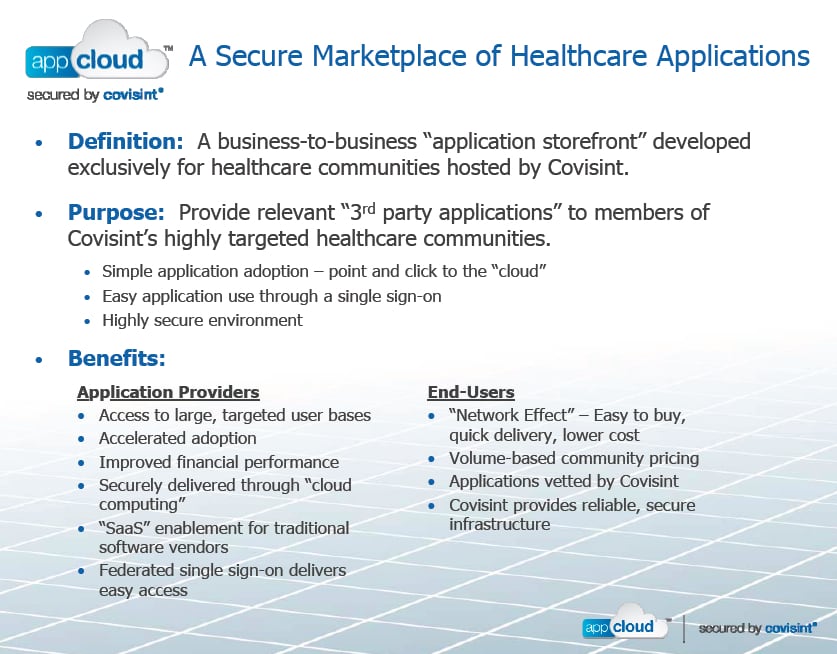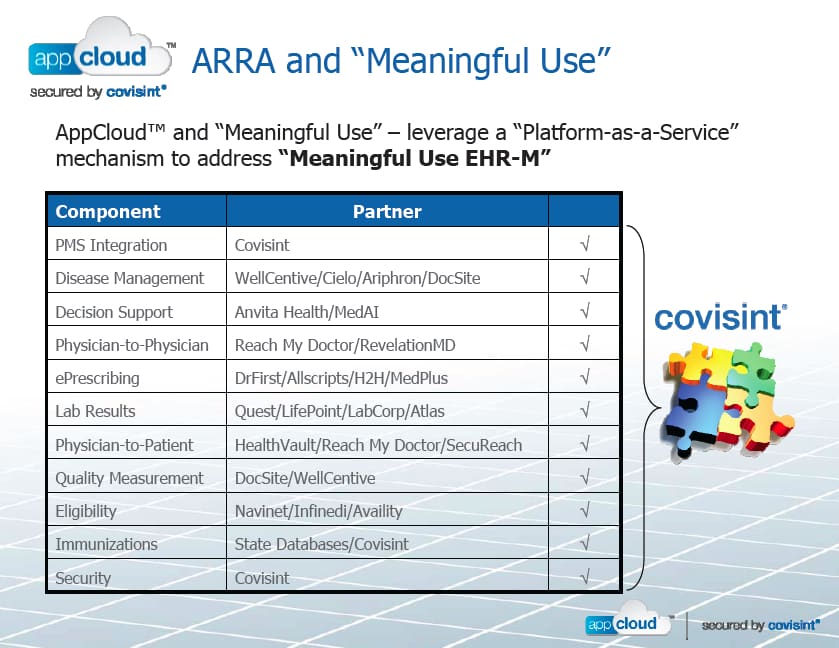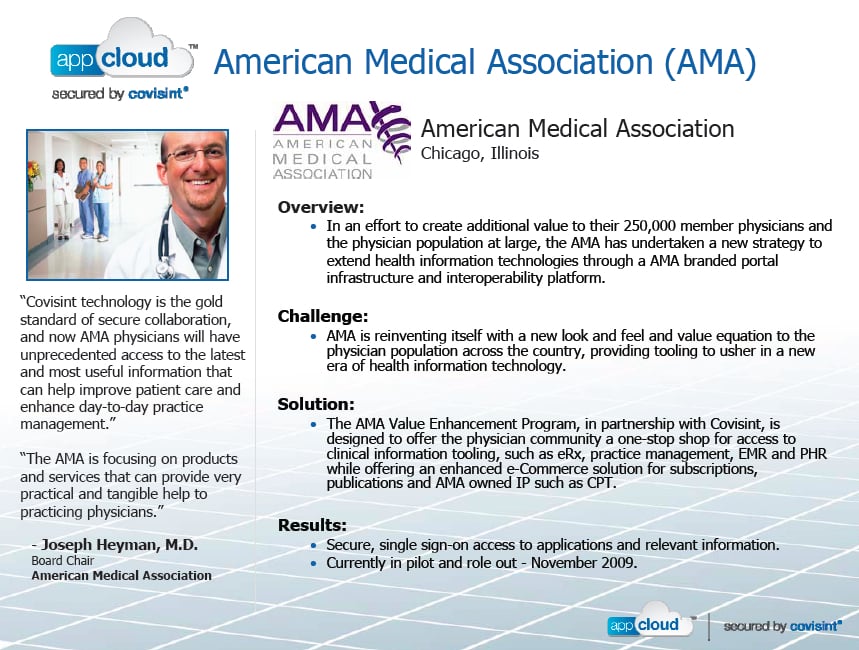A couple of weeks ago Chilmark Research did a small piece on the need for HIE vendors to move beyond silo’d standalone exchanges to a Platform as a Service (PaaS) model. In the write-up, the HIE vendor Axolotl was mentioned for their recent announcement of a third party image viewing app that was now available on their platform. In speaking with Axolotl’s President, Glenn Keet, he stated that this was the first app of many that would eventually be hosted on the platform. As Keet rightly put it; there are far too many needs in healthcare for any one vendor to satisfy and that partnershps wil be critical moving forward.
As a result of that post, Chilmark received several private emails from HIE vendors all stating that they were on a similar track to Axolotl’s. One of those who contacted us was Covisint, who announced their AppCloud last week. (for more background on Covisint, see the piece we wrote over a year ago) written We had a briefing with Covisint late last week and Covisint was kind enough to send us their slide deck from the Healthcare IT Summit where they announced AppCloud.



Looking Ahead:
While Chilmark Research may have been one of the first analyst firms to write on the topic of HIE vendors morphing into healthcare-centric PaaS, it appears that the vendors themselves have been spending some time thinking about this issue and how they can structure themselves to capitalize on this evolution in the market. The future battleground will likely be the fight for partners.
There are only so many stellar ISVs with broad brand recognition in the market. The Axolotls, Covisints, etc. will be out in the market courting the best-of-breed ISVs to build to their platform first and not a competitors. The skill and speed at which these HIE vendors can land those relationships will be a key metric to watch as this market, with $560M coming down the pike, shifts into high gear.




While single sign-on is a great offering, this is far from innovative. It is a list of links on a web page with some lightweight messaging. The physicians still need to remember to go into each application to conduct services. Functionality is replicated in multiple products. Who is conducting the workflow analysis to attempt to reconcile 11 application categories with a practice management system and electronic record system such as Allscripts? Who is going to take that information and change it into interfaces and notifications to guide the physician to go into the other systems? After that, who is going to support this as one or more of the 11 vendors + the practice management/electronic record vendor changes their underlying data structures, logic or navigation methods? Who is bringing together these vendor partners (term is used as loosely as possible) in a consistent and understandable structure that allows the physician to select services, rationalize duplicates, contract, receive and coordinate support, understand charges from the vendors, and resolve disputes?
This looks like the definition of information overload to me – just like first generation stand-alone blog readers without keyword searches, alerts and the ability to follow a feed. Better yet, it is a poorly produced song – “Physician Office PaaS,” by Covisnt, featuring MedAI, Wellcentive, Reach My Doctor, LabCorp, HealthVault and with special guest Allscripts. Where’s Kanye when you need a good comment?
You make some good points here Art. Do believe that the transition of the traditional HIE offering to one that is more of a PaaS is inevitable and Covisint is but one example, but one that is not necessarily fully mature by any stretch of the imagination. For example, choosing AllScripts as the first EMR offering seems like overkill and Covisint would likely be better off with smaller, more agile EMR apps. The only reason AllScripts is there is that this is who the AMA wanted on their platform which is based on Covisint. Same could probably be said for just about all the apps on Covisint today as Covisint and AMA began working on this concept earlier in 2009.
As for your other comments regarding the multitude of apps, well it really all depends on the job the physician is trying to accomplish. In some encounters he/she may need access to multiple apps, in other situations, only one. The underlying data structure, in a PaaS model is supported within Covisint and served up through the API into the various apps that a physician may invoke in the course of his daily practice. Apps that are easy and intuitive will succeed, those that are not will not be popular, not be adopted and fade.
Again, good points raised Art and HIE vendors would be wise to think these issues through as they launch their own PaaS. Sill early, still very immature, but this is the future of healthcare IT in the small ambulatory setting.
There needs to be more EMR lite applications in the market and more APIs for patient monitoring.
All Covisnt is offering via APIs is single sign-in. I am unaware of them even having patient context synchronized between the applications. As for an underlying data structure, they have no central data structure. I have not seen a comprehensive federated structure for their product. Even when you federate data, it still is placed in a virtual or physical model. I just see their product as single sign-in and a bunch of loose channel relationships. It also doesn’t address the functional duplications and the challenges that causes when you federate functions across applications and avoid shutting down duplicative functions in others. PaaS is yet another marketing channel to try and get this company on the radar screen. At least they haven’t tried to make Applications as a Simple Service of themselves yet.
As for physicians having to go to one application or multiple applications, look-and-feel and the ergonomics of the applications matter. If patient search isn’t consistent, training and user adoption will be a challenge. Microsoft, working with the UK, developed a consistent patient banner as well as other components in a consistent UI to help manage training, increase usability, and increase patient safety. Physicians want usability, they don’t want to waste time on training, they want their data to be available and exchanged between applications and they want to run reports from time-to-time. I fail to see how a loose bunch of applications can satisfy this demand. They are not marketing composite applications or even a worthwhile mash-up. Without a consistent user interface, some level of a physical or federated data model, data interfaces or integration, a single call for support model, a single licensing model and some recognition of different workflow needs for different practice sizes, specialties and configurations, it is just a single sign-on web page to me. I dare not even call it one of the former buzz words dujour, a portal.
So what if the AMA wants Allscripts, find other channel partners. Better yet, acquire someone that fits your architecture, truly integrate them and create the better mousetrap instead of this set of stand-alone applications.